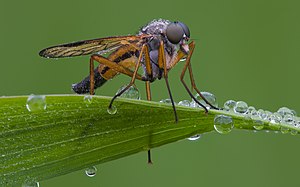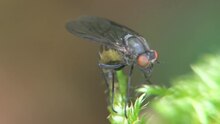Snipe flies
| Snipe flies | ||||||||||||
|---|---|---|---|---|---|---|---|---|---|---|---|---|

Common snipe fly ( Rhagio scolopaceus ) ♂ |
||||||||||||
| Systematics | ||||||||||||
|
||||||||||||
| Scientific name | ||||||||||||
| Rhagionidae | ||||||||||||
| Chvála , 1983 | ||||||||||||
| Subfamilies | ||||||||||||
|
The snipe flies (Rhagionidae) are a family of the two-winged (Diptera) and are assigned to the flies (Brachycera). 500 species of these medium-sized flies are known worldwide, around 35 of them in Germany. In 1973 the very similar members of the ibis flies (Athericidae) from the group of snipe flies were transferred to a separate family.
features
The flies are very slender and long-legged. The strong "trunk" that is used for food intake is striking. The abdomen is marked yellowish and dark in some of the more common species. The mouthparts are comparable to those of the horseflies (Tabanidae) and are very sharp.
Way of life
The snipe flies are mainly found in forests and on the edges of forests and often sit on tree trunks with legs apart and front body raised. Usually the head points downwards, for example in Rhagio scolopacea . They mostly feed on small insects and probably also ingest honeydew and plant saps. The species in the genus Symphoromyia suckle blood in vertebrates and also in humans. The females of some foreign species also feed exclusively on nectar .
Larval development
The female snipe flies usually lay their eggs one by one on the ground, in dung or rotten wood. The larvae are elongated and have an incomplete head capsule and mouth hooks formed from the mandibles and maxillae . The body is equipped with weak creeping bulges. They live on and in the ground, between moss, leaf litter, in dung and under bark, and mostly feed on small insects. The larvae of Rhagio scolopaceus like to attack earthworms . They are also likely to eat decaying plant and animal matter. The snipe fly pupae live in the ground. The overwintering usually takes place as a larva.
Fossil evidence
The oldest fossil evidence comes from Jurassic formations in various places in Central Asia and China. Further Mesozoic evidence goes back to finds in Siberian amber . The vast majority of fossil snipe flies are known from tertiary amber deposits, especially from the Eocene Baltic amber .
Types (selection)
- Chrysopilus cristatus
- Chrysopilus laetus
- Common snipe fly ( Rhagio scolopaceus )
Individual evidence
- ^ Brian R. Stuckenberg: The Athericidae, a new family in the lower Brachycera (Diptera). In: Annals of the Natal Museum. 21, 1973, pp. 649-673.
- ^ Family Rhagionidae. in the Fossil Diptera Catalog
- ↑ George O. Poinar, Jr .: Life in Amber. Stanford University Press, Stanford (Cal.) 1992, ISBN 0-8047-2001-0 .
literature
- J. Haupt, H. Haupt: Flies and mosquitoes - observation, way of life. Augsburg 1998, ISBN 3-89440-278-4 .
- K. Honomichl, H. Bellmann: Biology and ecology of the insects. + CD-Rom. Gustav Fischer Verlag, Stuttgart 1994.
